Needless to say, defense is the foundational component of basketball. The potential win or lose, not only depends upon better offensive play but a solid defensive play as well. The Principles of defensive strategies have been defined which can lead to team conquest when followed and implemented properly. Because of the prime focus on the offensive strategy players usually lack the grip over the defensive ones. However, the coaches still expect the players to be able to go out-guard outstanding offensive opponents. Yet this can’t be achieved without a thorough knowledge of basic defense principles and concepts.
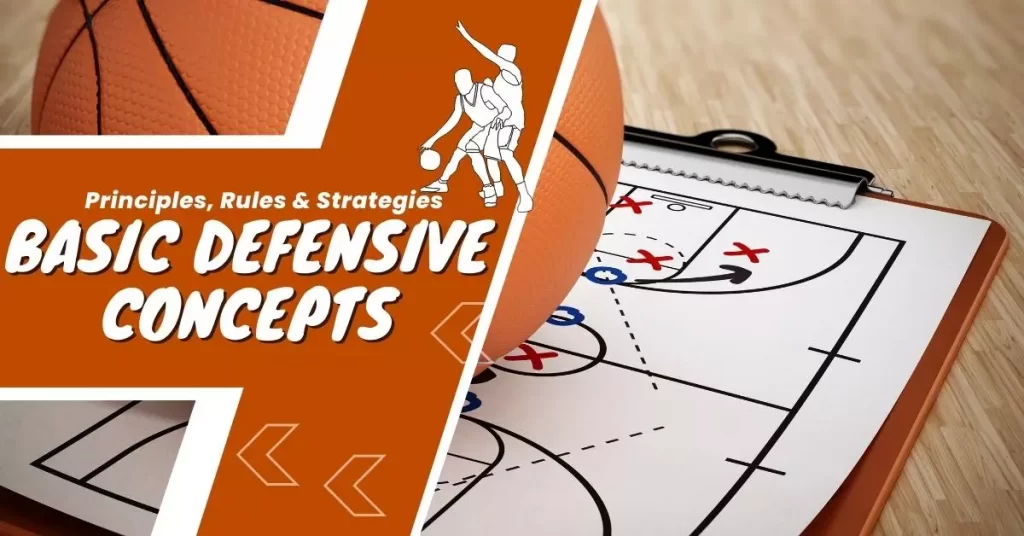
The principles comprise basic defensive concepts including trap zone, red zone, push points, Helpside “I”, and Box Pressure collectively. Because of the;
1. Trap Zones
The out-of-bound lines in basketball are considered the boundary that separates the inbound zone(the court area) from the outbound zone(the outside court area). These out-of-bound lines work as tenacious defenders for the defensive team. Leveraging these lines by trapping the opponent includes one of the basic defensive strategies executed by the defensive team. The Trap zone is normally divided into two, i.e: The Primary trap zone and, the Secondary trap zone.
Primary Trap Zone:
Primary trap zones define the corners of the court. There are a total of 6 primary trap zones, 2 in the backcourt and 4 in the frontcourt. The defenders can fully exploit these two out-of-bound lines by trapping the offensive players and restricting them in a particular zone.
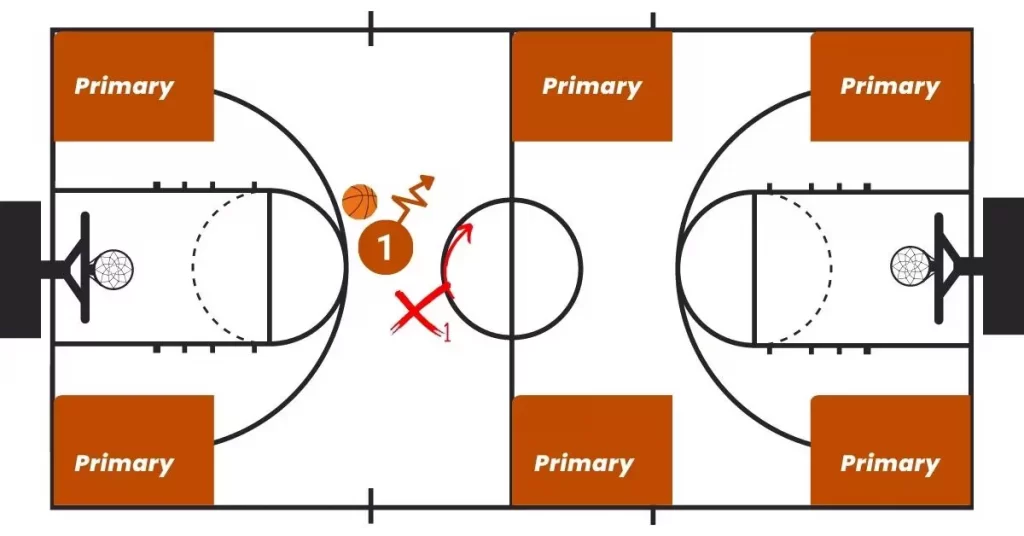
Secondary Trap Zone:
The secondary trap zone refers to the sideline and baseline areas of the court, which includes one out-of-bound line into play. Constant forcing of offensive players towards the secondary zones traps the ballhandlers in one area minimizing their potential ability to score and play.
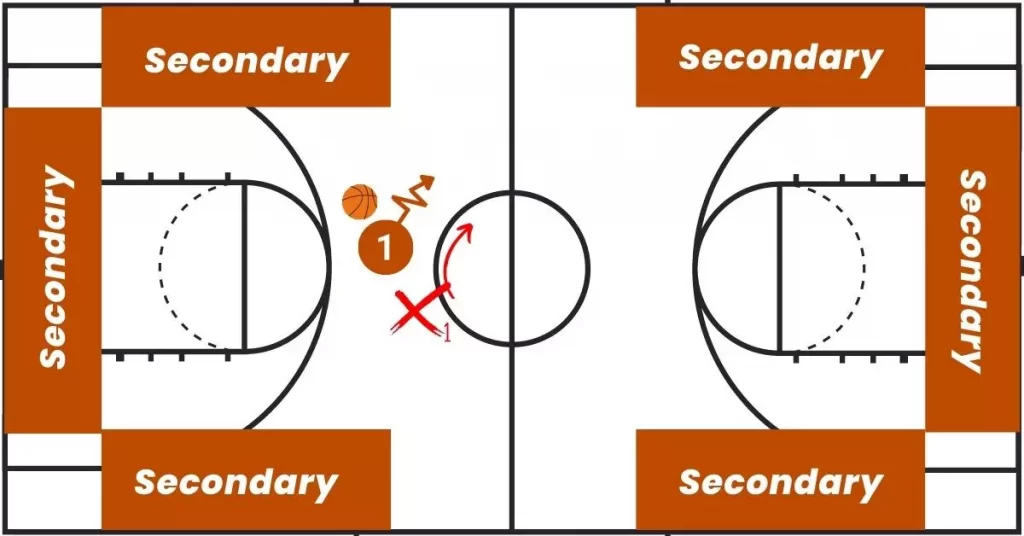
2. Red Zone
The “red zone” lies in the width of the free throw lanes and runs the full length from the end-line to the baseline on the court. Thus, in the scenario, keeping the ball “out of the middle of the court” results in a restricted area for the offense to play and in addition, the help side support for the defensive is also generated.
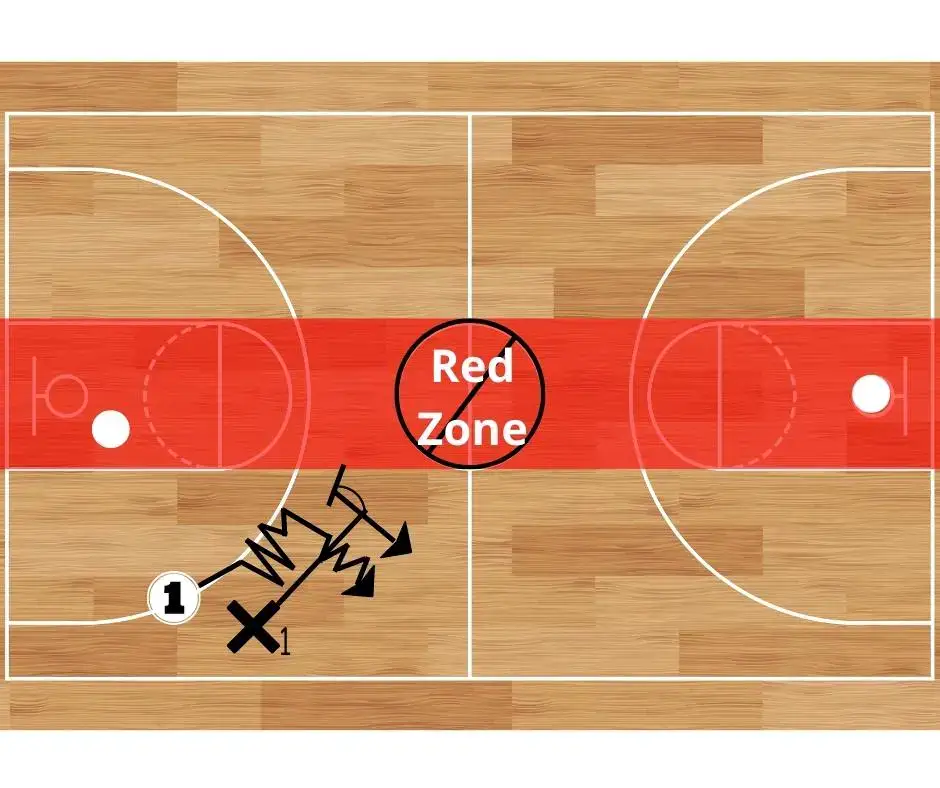
Middle Penetration:
The defenders should keep on pushing the offender to the sideline. The play in the middle by the offender may result in easy shots, layups, and kick-out pass for an open 3-point shot, consequently costing the defensive team. Therefore, the defense should restrict the middle play and enforce the player towards the sideline anyway. However, when gets difficult to turn over the dribbler towards the sideline, forcing him across the red zone to the opposite sideline is the feasible solution.
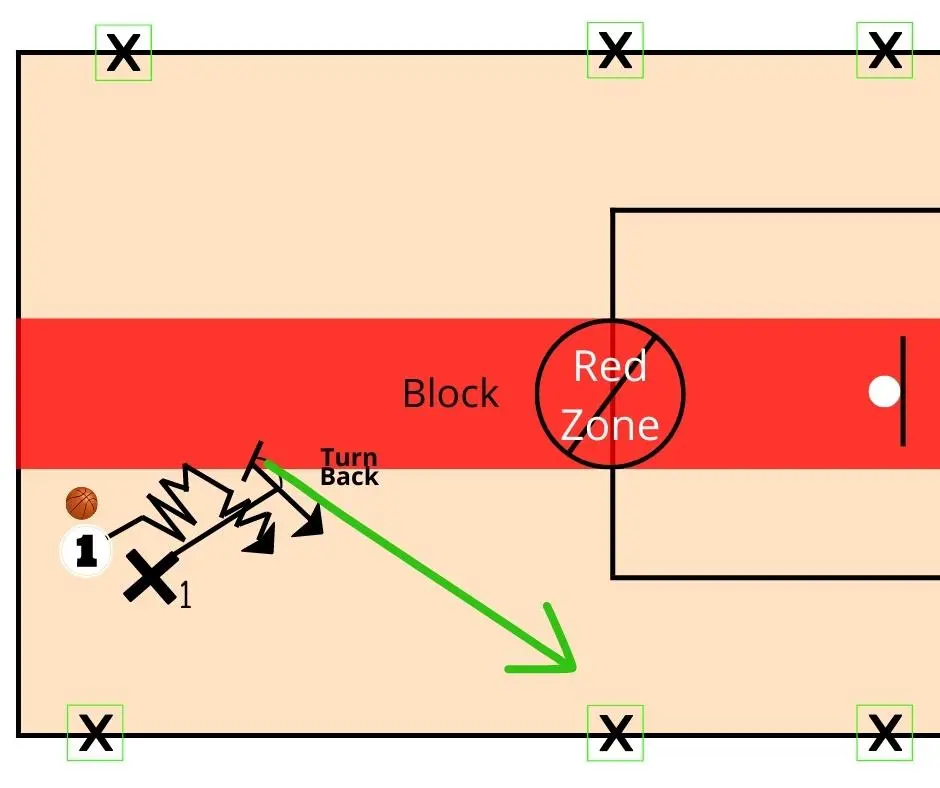
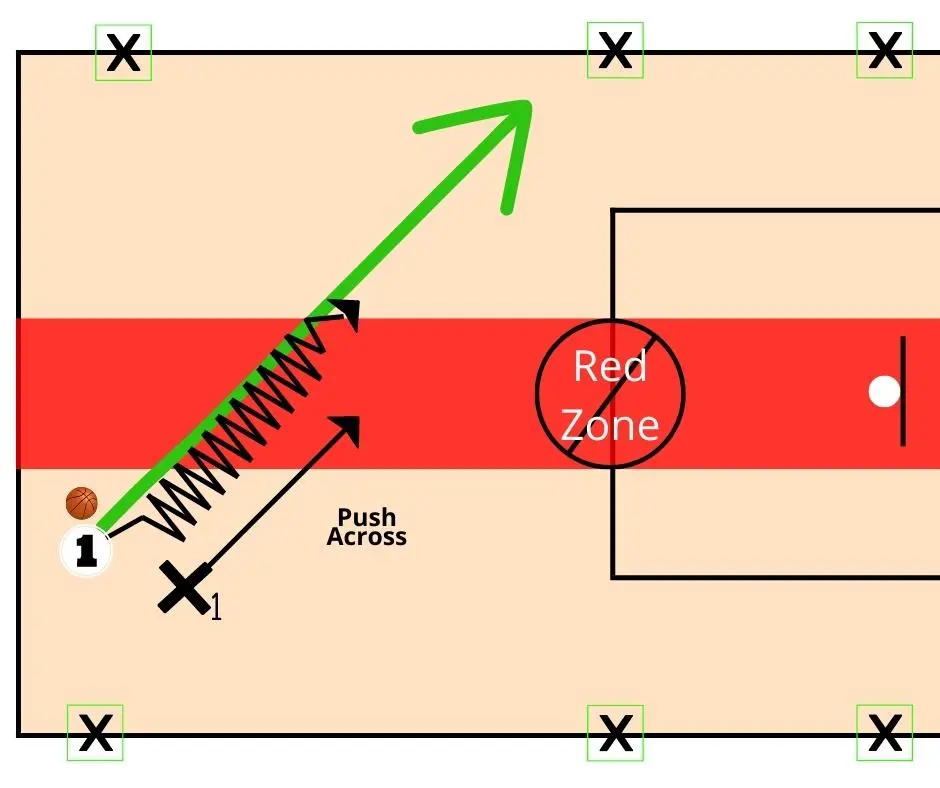
3. Pushpoints
The push points play a significant role in restricting the offensive play area. These are the specific points in the court located along each baseline and sidelines. The exact locations(of push points) mainly are corners, free throw line extended, baseline, and half court. The approach is implemented in a way, that offenders are supposed to thrust the ballhandler towards any of the feasible and relevant push points to cut down their area of play and confine their moving ability.
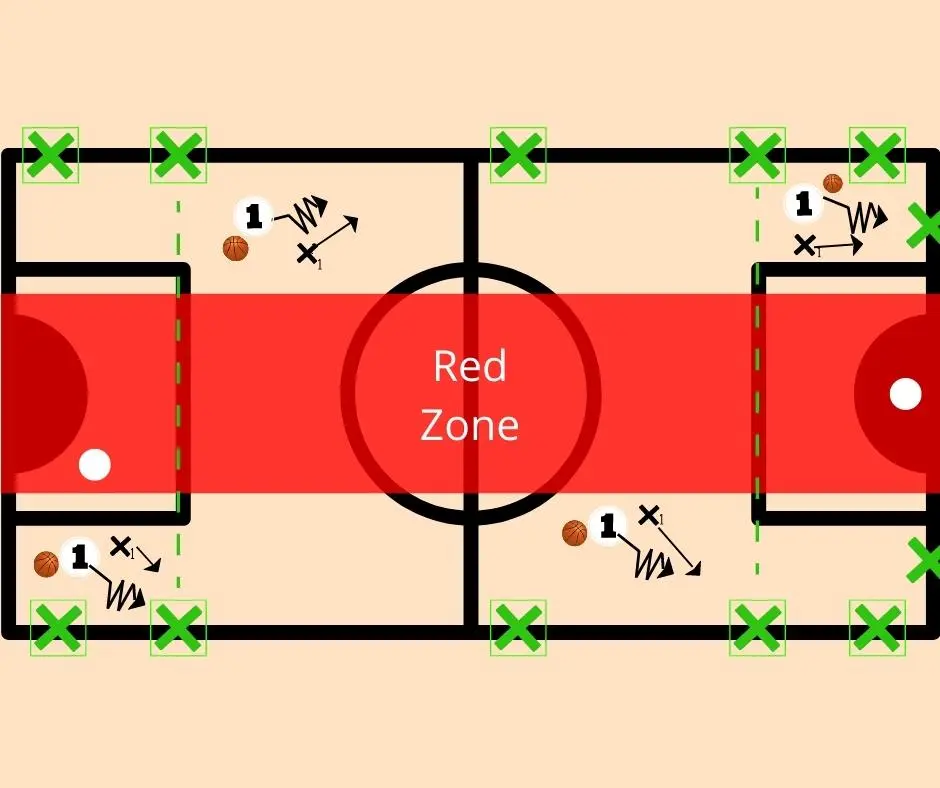
When the player fails to push the opponent to the desired push point, he may choose to influence the player with the ball, to the next nearest push point. Two scenarios are commonly seen to occur in push points play. It includes:
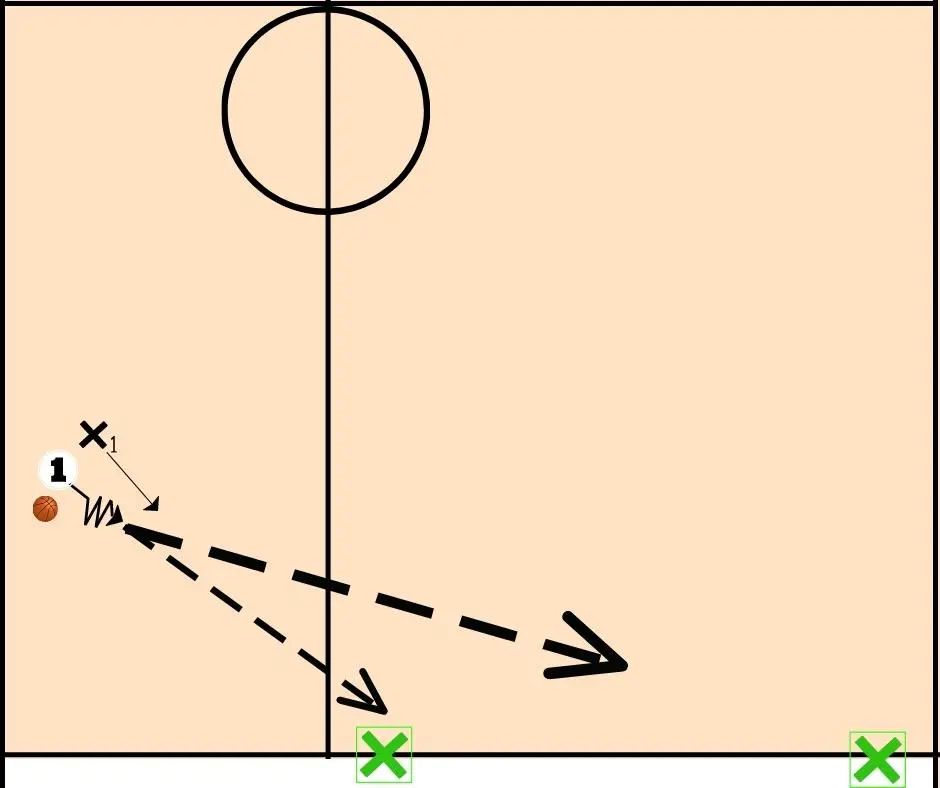
The pushing of the ballhandler to the below block, towards the baseline push point, is prioritized usually when the ball is on the wing. However, if the player with the ball chose to drive towards the middle of the court, it is advised to push the dribbler over the top of the circle.
Ball Located on the Wing:
The pushing of the ballhandler to the below block, towards the baseline push point, is prioritized usually when the ball is on the wing. However, if the player with the ball chose to drive towards the middle of the court, it is advised to push the dribbler over the top of the circle.
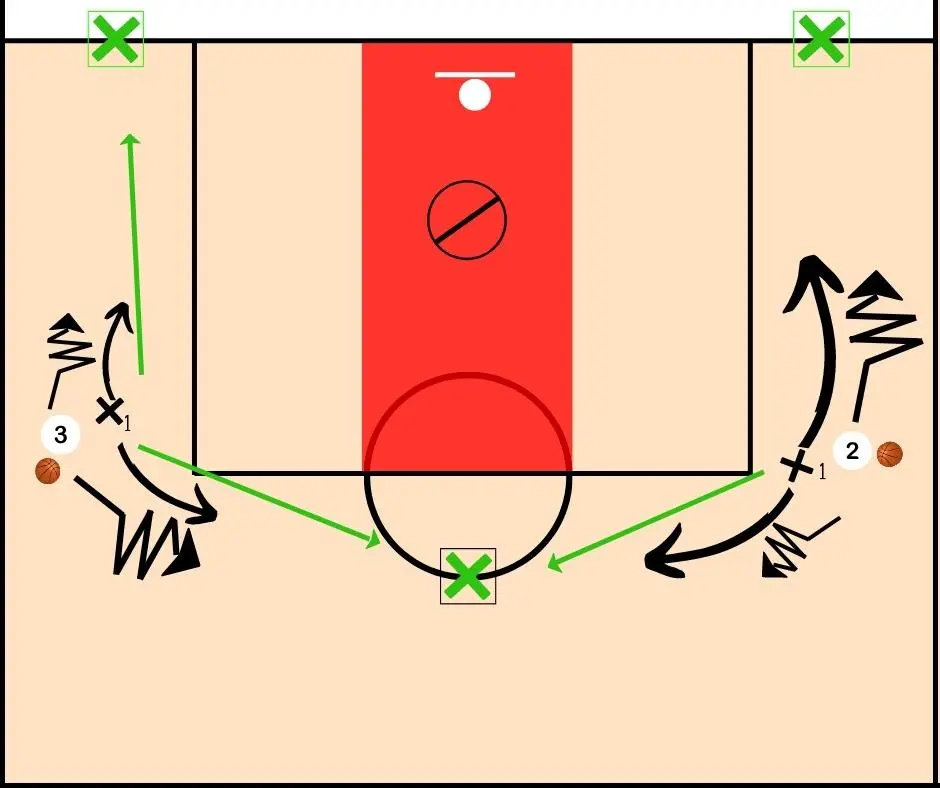
Ball Located at Top of Circle:
The ballhandler when appearing to drive to the high post area must be pushed and forced towards a corner push point.
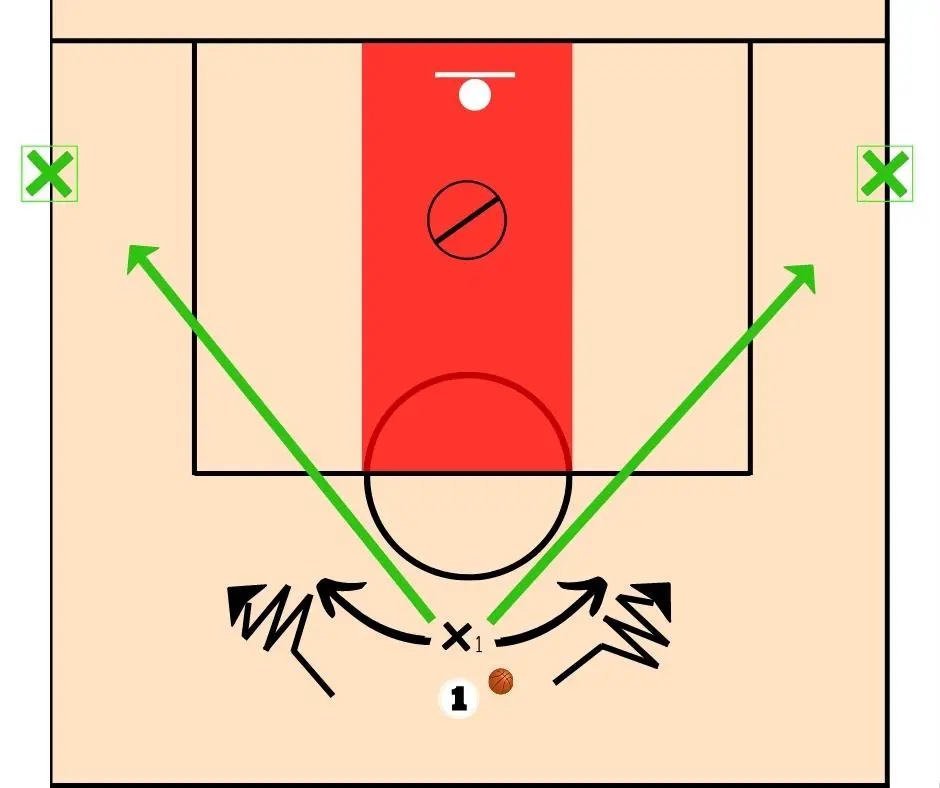
4. Helpside “I”
The Helpside in the defense acts as spine support. Ideally, the ballhandler must be influenced by the sideline “Push Points”, in order to cut down the playability of the offense overall. This usually benefits the defensive players playing on opposite sides of the court in sagging off their opponents. leading to creating a strong backside support position. This position refers to “Helpside I”.
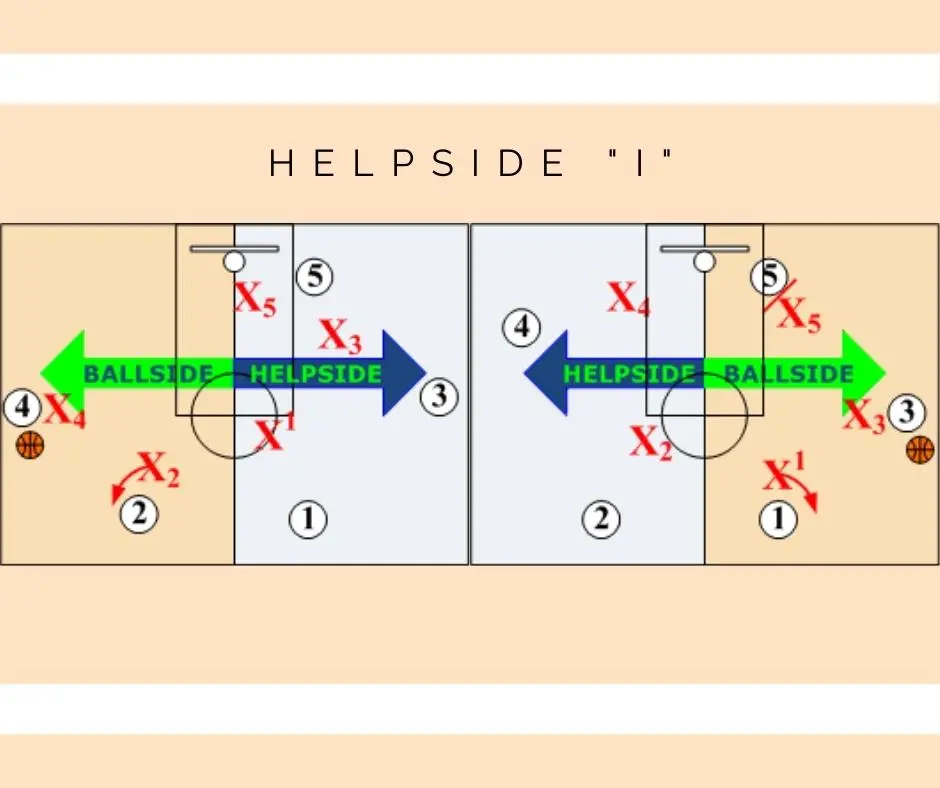
The prime concept is to force the dribbler towards the corner or the push point(sideline in the case), along with preventing ball reversal, which results in restricting them to a specific area/corner.
The exceptional usefulness of Helpside “I” execution outcomes in reduced efficient offensive play on the court, denying ball cuts, taking charges, and rebounding. Additionally, the resultant teammates in the team-up and double team eradicate the one-to-one isolations too. Helpside “I” is further broken into two depending upon the alignment, Double “I” (Low/High) and Triple “I” (Low/Mid/High).
Double “I” (Low/High):
When the post is deployed on the ball side of the court, Double “I” (Low/High) comes into execution. Two players align themselves in their respective positions, referred as to Low and High positions to strengthen the team with their back support.
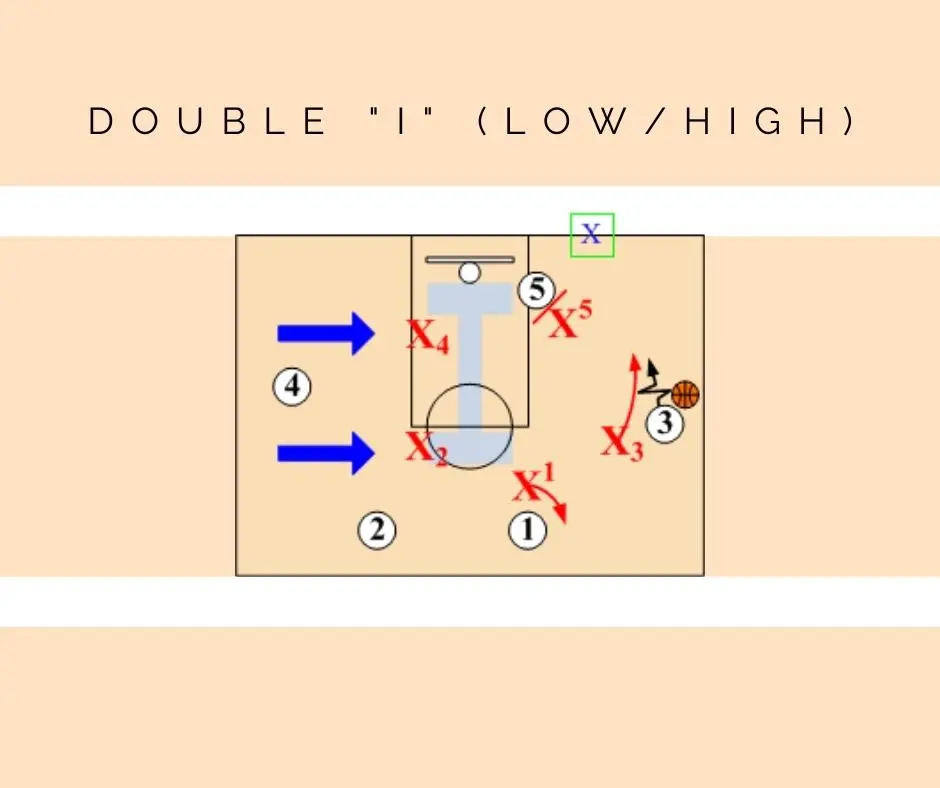
Triple “I” (Low/Mid/High):
As a consequence when the offense deploys the post on the side of the court away from the ball, Triple “I”(Low/Mid/High) alignment is created. This alignment allows three players with their three respective positions of Low, Medium, and High, to provide defensive help, where any of the players can trap the offense by rotating as well.
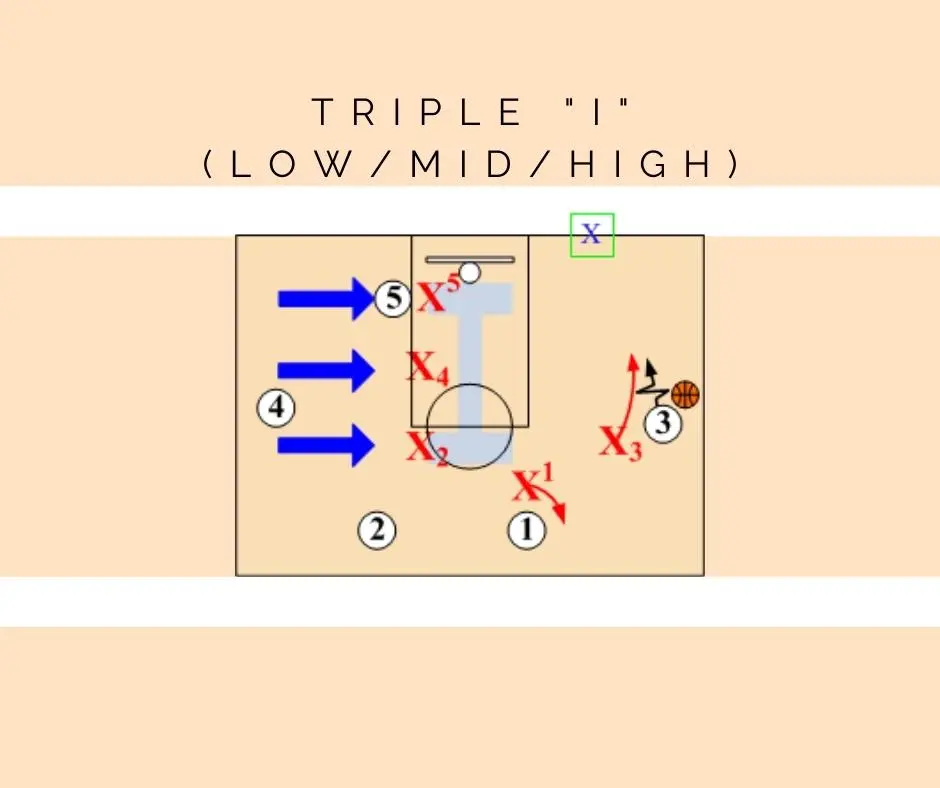
Inverting on Help Side:
INVERTING the positions can be done anytime when the players in the “Helpside I” identify, a big player being in a “High I” position and a smaller player in a “Low I” position, by simply interchanging.
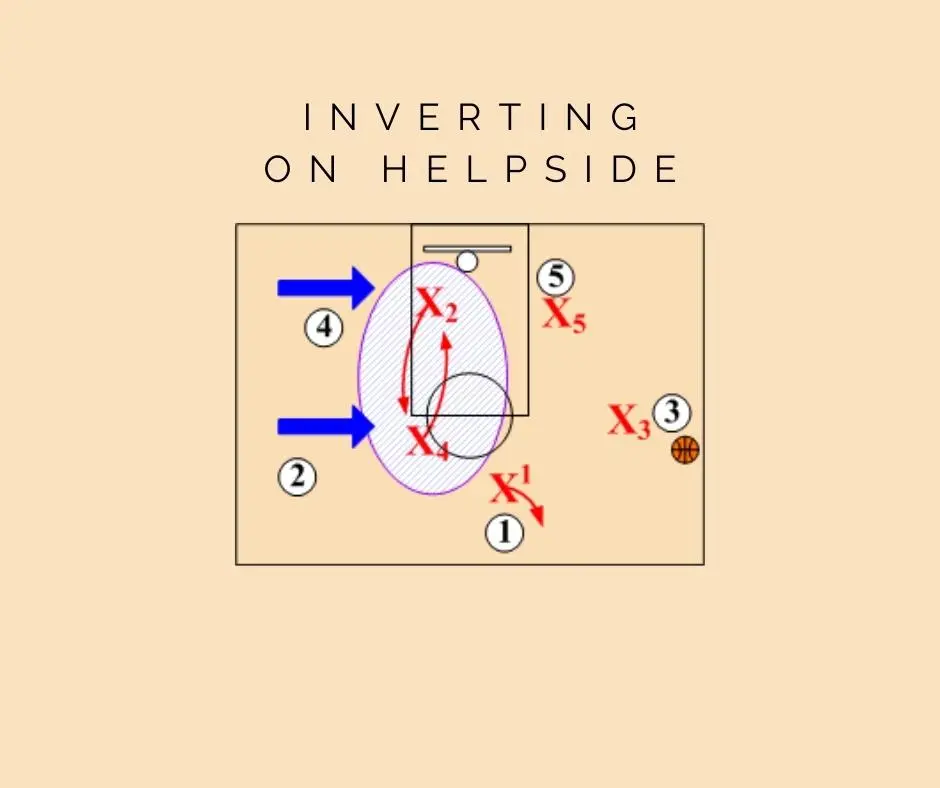
5. Box Pressure
Forcing and restricting the ballhandler towards the corner or near the push points, be it baseline or sideline ones, are usually achieved by the team effort. The disruptive pressure put by the defensive team influences the player with the ball to move towards a particular position, mainly the easy to confined position. The team then traps the players forming a box and puts utmost pressure to defeat.
While the main offensive player enforces the dribbler towards the push points or corners, the rest must assume and align themselves in Helpside”I” positions, denying the reversal pass.
The mention-worthy benefits of Box Pressure do not only include significant numerical player advantage, yet also limit the offensive overall playing ability. The various layouts that may form are:
Five Against Three Defensive Advantage:
When the offensive post sets up on the ball side of the court, the 5-against-3 box is established.
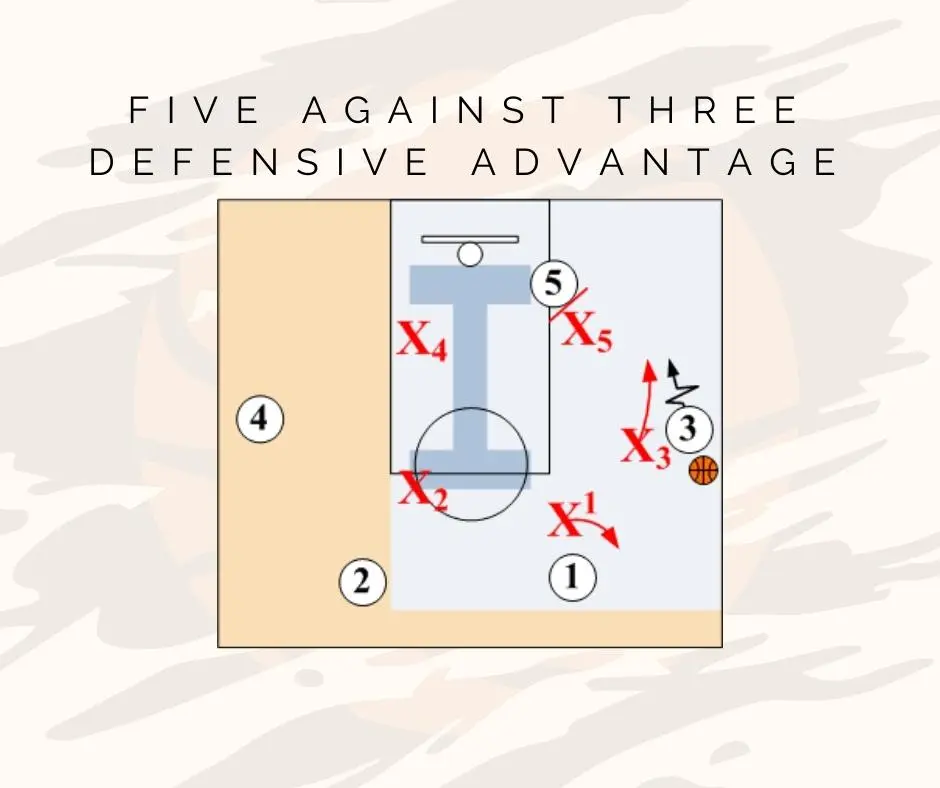
Five Against Two Defensive Advantage:
The bigger advantage for the defensive may create in case the offensive team assumes a weakside position. In this scenario, the alignment can become 5 (seven if you count the two out-of-bound lines) against 2.
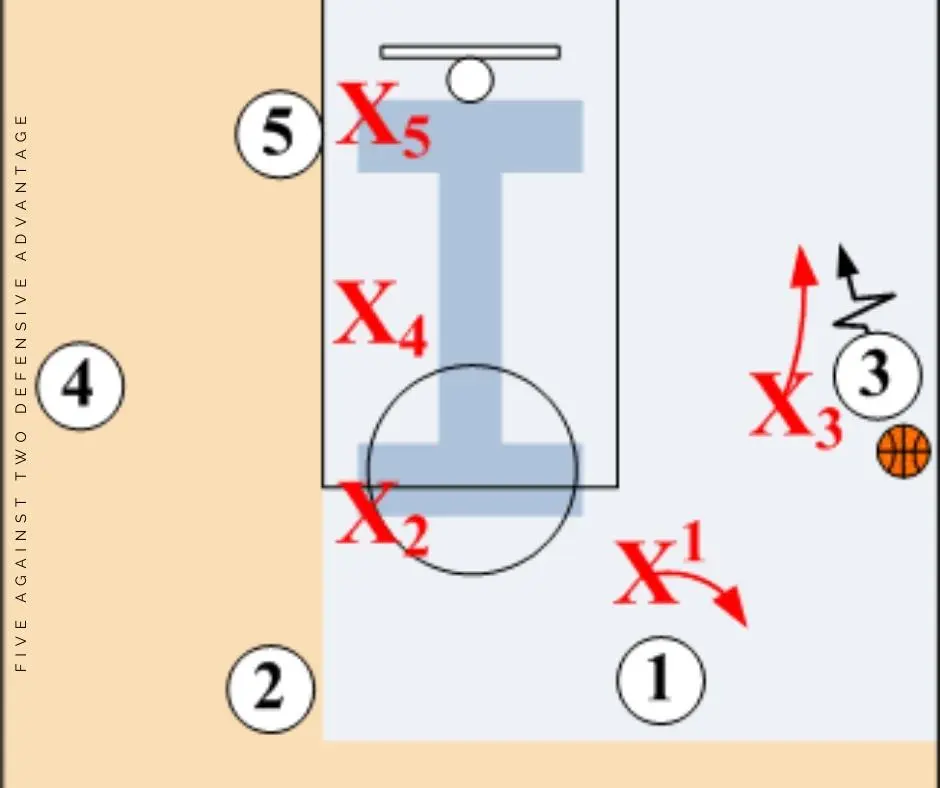
What Are the Basketball Defense Rules? 3 Basic Rules
Defense can be executed in court under certain criteria. The defense rules spell out the circumstances whose outcomes may demand and result in Defensive strategies implementation. The attempt to make defense should be implemented ensuring following the defined rules else wise it usually consequence in fouls in the game. Hence, understanding the defense rules is foremost and prior to being an expert player and all-around defender.
The three must-follow rules are Legal Guarding Position, Secondary Defender & Defensive Three-second Rule.
1. Legal Guarding Position Rule
According to the National Collegiate Athletic Association, the player is said to be in the legal guarding position when he directly faces the opponent with both feet on the ground. Once, a defender established a legal guarding position, under the LGP rule, it’s mandatory for the offensive player to keep on changing directions and be in continuous motion with respect to the defender’s position, in order to avoid direct contact with the defender.
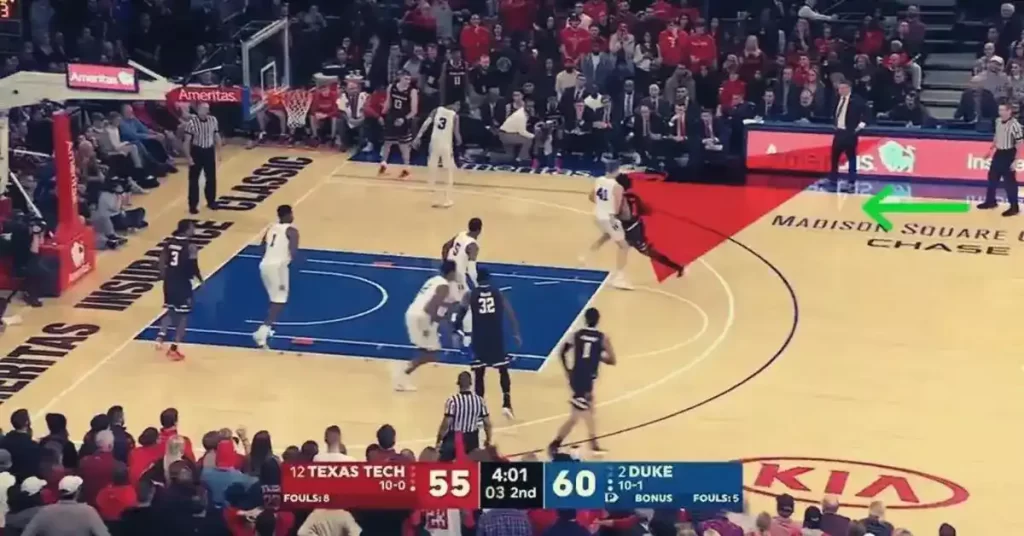
Solid rules are defined in order to establish a Legal guarding position by adapting the exact positions and movements of the player. Any contact of the offender with the defender in a legal guarding position falls under the rule of incidental contact and thus results in a foul(on the offense). Therefore, it’s obligatory for the defender to move right, left, or towards the back while keeping the same legal guarding position/posture, and for the offender to move/change directions once the defender establishes the LGP.
Recommended to read: Become a Better Basketball Player
2. Secondary Defender Rule
A secondary defender is one, who isn’t actively defending one-to-one an offender, but rather as a side defender with the primary defender. The role of the secondary defender is to indirectly defend the ballhandler moving toward the basket, however, under the rules of the NBA, the secondary defender is not allowed to draw an offensive foul while underneath the basket. The semi-circle marked under the basket is the marker to determine and ensure the non-violation of the particular rule.
3. Defensive Three-Second Rule
The three seconds rule states that a player of the team can not stay in the team’s foul lane for more than three seconds, while the player’s team has possession of the ball. The offender when staying in the paint for 3 seconds, violates the 3-second rule. Similarly, if the defender when dwells in the paint without guarding/defending any offensive player for 3 or more seconds, 3-second violation is considered. Additionally, the player with one for touching the boundary is supposed to break the 3-second rule.
In case of violation of the rule, the ball is turned over to another team and is awarded out of bounds to the team on the side of the court at the free-throw line extended.
What Are the Strategies for Basketball Defense? Tactics of Defense
Tactics are usually implemented by an individual player of the team and not as a whole. These are considered the actions and practical approaches that when perpetrate properly may result in favorable outcomes for the defensive team.
The primary tactics/strategies include the closeout, denial defense, and double team.
Closeout:
The closeout in basketball refers to the situation when the on-ball defender tries to prevent/limit the contested jump shots and dribble penetration by the ballhandler, by reducing the gap between him and the specific offender. The defender attempts to lessen the gap by taking long steps toward the ballhandler, alongside maintaining a good defensive stance.
Once completely “closing”/Finishing the gap in between, the defender tends to take short steps onwards. The choppy steps ensure not to make unnecessary contact with the offender, which may lead to a foul else wise.
Denial Defense:
Denial defense is also termed as denying the pass or denying the ball, after the logic when the on-ball defender places himself adjacent to the ballhandler to intercept his pass/ball by the other teammate. The prime benefit of the denial defense is that it interrupts the flow of the offensive play, especially when the team’s star player is put into the denial defense phase.
The right posture of an offender to conduct the denial defense is one foot between the feet of the denied ballhandler, the other slightly above, the forearm opposite of the ballhandler, arm and hand that is closest to the ball fully extended in the passing lane, and palm towards the ball.
Double Team:
As the name shows, the double team refers to teaming up in order to defend the dribbler and prevent him from scoring particularly near the basket or the perimeter. Two players, that is the primary and the secondary, collectively runs the double team strategy. However, the secondary defender should typically wait until after the player with the ball has already started their dribble or just finished their dribble.
Recommended to read: How to Improve Dribbling in basketball
To perform the double team, both the players lock their adjacent feet to finish the space between them in order to consummate the dribbling space and escape route. They also tend to place their hands high up, to intercept the options of passes. Moreover, both the defenders by keeping their hands up can mirror the pass, which may lead to a turnover. However, both defenders should not try to steal the pass from the ballhandler which may result in a foul.
The defense is key to taking control of the game. Strong defense leads to a potential win undoubtedly. The out-of-bounds line and the push points on the court are tenacious unassuming defenders that are 3x the defensive power of the defense. All the players have to learn is the correct and valid approaches to implement and make use of them.
Preventing dribble penetration and trapping techniques should be the must-learn points in the players’ guide as they bring out major restrictions on the offense’s overall playing ability. The proper enactment of the rules is the foremost key to a winning game.